Cosmelan Peels
The Cosmelan Peel by Mesoestetic is a professional-grade, multi-step depigmentation treatment designed to target all types of hyperpigmentation. Hyperpigmentation is a common term in dermatology for areas of skin discoloration that are darker than a person’s natural skin tone. It results from an overproduction of melanin, which can be caused by factors such as sun damage, old acne scars, underlying medical conditions, hormonal fluctuations, certain medications, and more. While some hyperpigmentation can be treated with lasers, others—like melasma or post-inflammatory hyperpigmentation—require gentle chemical peels to avoid worsening. Additionally, individuals with darker skin tones may not be suitable candidates for many laser treatments. Fortunately, Dr. Green offers the Cosmelan peel at her New York City dermatology practice to treat hyperpigmentation and melasma in patients of all skin tones and types.
The Cosmelan Peel reduces excess melanin and controls its production in both the epidermis and dermis layers of the skin. The treatment involves applying the Cosmelan 1 mask in-office by Dr. Green, followed by a home care phase with specialized skincare products, including the Cosmelan 2 depigmenting cream. Unlike other hyperpigmentation treatments, the Cosmelan peel is safe for patients with melasma and suitable for all skin types and tones, including darker skin. It has minimal potential side effects, little downtime, and consistently impressive cosmetic results. The Cosmelan peel is one of the most popular procedures at Dr. Michele Green’s private dermatology practice in New York City for achieving healthy, radiant, and even skin.
Dr. Michele Green is an internationally recognized, board-certified cosmetic dermatologist with over 25 years of experience offering some of the world’s most discerning individuals top non-invasive treatments, including Cosmelan for hyperpigmentation and melasma. Dr. Green takes a holistic approach and advocates a less-is-more philosophy for skin rejuvenation, tailoring each patient’s treatment plan to their specific needs and aesthetic goals. She is consistently honored by Castle Connolly, New York Magazine, The New York Times, and Super Doctors as one of New York’s top dermatologists for her dedication to her patients and her expertise. She is among the few dermatologists in New York City who offer the Cosmelan treatment to help achieve a healthy, radiant, and even skin tone.
What is Cosmelan depigmentation treatment?
The Cosmelan peel is the top depigmentation treatment worldwide, designed to remove hyperpigmentation and control melanin production to prevent recurrence. Excess melanin, which gives skin its color, can cause hyperpigmentation and lead to feelings of low self-esteem. The Cosmelan peel can effectively reduce or eliminate melasma, post-inflammatory hyperpigmentation from old acne scars, skin discoloration from excessive sun exposure, and other forms of hyperpigmentation. It not only removes existing melanin but also blocks tyrosinase activity, an enzyme key to melanin creation. After a Cosmelan peel, patients can enjoy long-lasting results and clear, glowing skin.
The Cosmelan peel involves two steps. First, an expert like board-certified dermatologist Dr. Green applies the Cosmelan 1 mask. This mask is worn for a specific time set by Dr. Green, depending on the patient’s level of hyperpigmentation, skin tone, and skin type. When the time is up, the patient removes the mask at home using a gentle cleanser. The second step requires the patient to follow a home treatment routine that includes the specially formulated Cosmelan 2 cream, a depigmenting product with active ingredients such as kojic acid, salicylic acid, ascorbic acid, retinol, and Mesoestetic’s proprietary Cosmesome complex. Dr. Green will also recommend a specific Mesoestetic moisturizer and sunscreen to complement the Cosmelan 2 cream, helping preserve and enhance the treatment results. After finishing the Cosmelan treatment, Dr. Green will design a personalized skincare plan to help you maintain your results and achieve long-lasting, clear, radiant skin.
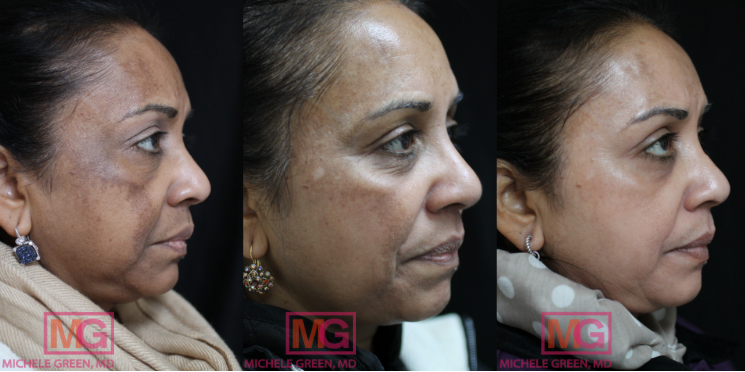
Before and after – 3 parts, Cosmelan treatment
What is Cosmelan 1?
Cosmelan 1, also called the Cosmelan mask, is the first step in the Cosmelan peel treatment. The Cosmelan 1 mask contains depigmenting agents such as salicylic acid, retinol, ascorbic acid, kojic acid, arbutin, phytic acid, and two patented depigmenting compounds (melaphenone and cosmesome). Cosmelan 1 works by removing excess melanin from the skin’s surface through exfoliation and destroying melanin in keratinocytes via autophagy, or “self-devouring” action. It also helps regulate melanin production, reducing melanogenesis and the transfer of melanosomes to the skin’s surface. Because Cosmelan 1 has a high concentration of active ingredients, it should only stay on the skin for the time recommended by your healthcare provider, usually 4 to 8 hours. After this, the mask is rinsed off, and patients are advised to follow a structured at-home skincare routine.
What is Cosmelan 2?
Cosmelan 2, also known as the Cosmelan cream or Cosmelan depigmentation cream, is a specialized cream designed to enhance the effects of the Cosmelan 1 Mask and help control melanin production. Its formula contains a similar mix of active ingredients to Cosmelan 1, but at lower levels, allowing patients to use Cosmelan 2 cream regularly without irritation or adverse reactions. The Cosmelan 2 cream is formulated to strongly inhibit melanin synthesis, promote melanin autophagy, block gene expression of enzymes that drive melanogenesis, and decrease tyrosinase activity. It also works to correct excess pigmentation through exfoliation. The Cosmelan 2 cream should be applied 7 days after removing the Cosmelan 1 mask and can be used once or twice daily based on the patient’s sensitivity.
How does the Cosmelan peel work?
The Cosmelan peel functions as both a corrective and regulatory treatment. It reduces excess melanin and controls melanin production to lessen or eliminate various types of hyperpigmentation, including melasma, post-inflammatory hyperpigmentation caused by acne scars or surgery, sun damage, and other skin discolorations. Using a proprietary blend of active ingredients, the Cosmelan peel can:
- Exfoliate the skin to accelerate skin renewal and eliminate melanin buildup in the skin’s superficial layers.
- Induce autophagy action to eliminate melanin in keratinocytes.
- Reduce melanin production and diminish dark spots on the skin.
- Prevent the transfer of melanosomes from melanocytes to keratinocytes, thereby inhibiting pigment migration into the epidermis.
- Reduce and inhibit melanin synthesis.
- Inhibit the activity of the tyrosinase enzyme, which is responsible for the initial step in melanin production.
- Reduce gene expression of enzymes that activate melanogenesis.
Is Cosmelan a chemical peel?
Yes! A chemical peel is a cosmetic procedure that uses a chemical solution on the skin’s surface to remove the outer layers. The chemical exfoliation process speeds up skin cell turnover, revealing new, healthier skin cells that appear more even in tone and texture. The Cosmelan peel is a specific chemical peel designed to reduce melasma and hyperpigmentation. Its formulation contains exfoliating ingredients such as retinol and salicylic acid to promote skin cell renewal, as well as skin-lightening agents like kojic acid and ascorbic acid to correct and regulate melanin production.
What types of hyperpigmentation does the Cosmelan peel treat?
Thanks to its gentle approach, the Cosmelan peel can effectively treat nearly all types of hyperpigmentation, including melasma that doesn’t respond to laser treatments. Additionally, Dr. Green often uses the Cosmelan peel to address cases where patients have worsened hyperpigmentation after improper laser treatments. Some of the main skin conditions Dr. Green treats with the Cosmelan procedure include:
- Melasma
- Post-inflammatory hyperpigmentation (PIH) from old acne lesions or improper laser treatments
- Sunspots and age spots
- Discoloration due to sun damage
- Dark spots and pigmented blemishes
- Uneven skin tone
- Dark marks from acne scars
Who is a good candidate for Cosmelan treatment?
A suitable candidate for Cosmelan treatment is someone in good physical health who wants to treat persistent or unwanted hyperpigmentation on their skin. Patients should avoid Cosmelan if they are allergic or sensitive to retinol, salicylic acid, or any other ingredients listed in the Cosmelan 1 and 2 formulas. It is not suitable for those with active acne, eczema outbreaks, skin infections, or skin injuries in the treatment area. Patients should also hold off if they have taken isotretinoin (Accutane) within the past six months. Additionally, pregnant and breastfeeding women should not undergo the Cosmelan peel because of the ingredients. When you see Dr. Green at her private dermatology office in Manhattan’s Upper East Side, she will review your full medical history, check any previous cosmetic procedures, and examine your skin to see if you are a good candidate for Cosmelan treatment.
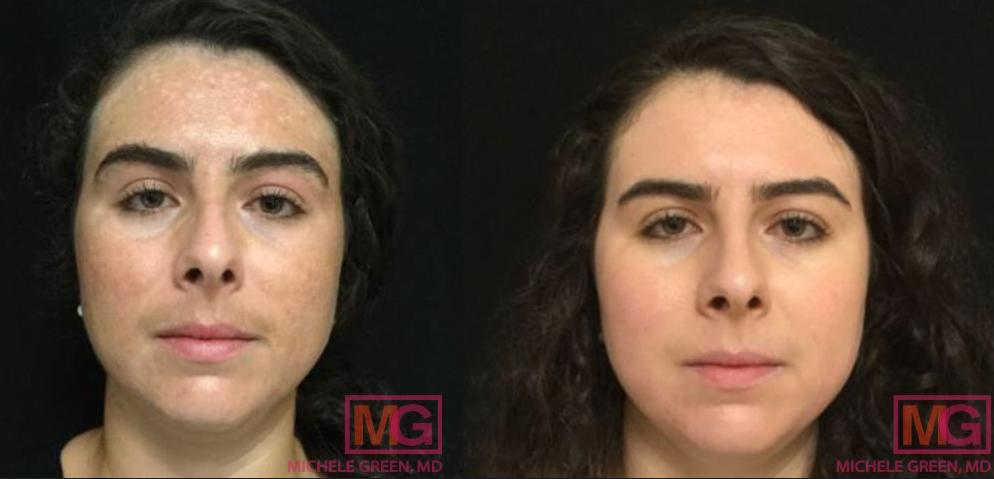
How to apply Cosmelan peel
Cosmelan treatment involves a two-step process: applying the Cosmelan 1 mask, followed by a strict at-home care regimen with Cosmelan 2 depigmentation cream and other Mesoesthetic skincare products. Only trained healthcare professionals, such as board-certified dermatologist Dr. Green, perform this treatment because they are specifically qualified to apply the Cosmelan 1 mask. Patients first schedule a consultation with Dr. Green at her private New York City dermatology practice to assess whether the Cosmelan treatment is suitable for their individual skin type, tone, and hyperpigmentation. Dr. Green may perform a test spot with the Cosmelan peel to check for any allergic reactions to its ingredients. Once it is confirmed that the person is a suitable candidate for the Cosmelan peel, the initial mask application will be scheduled with Dr. Green.
How to use Cosmelan 1 and Cosmelan 2 with board-certified dermatologist Dr. Green
When you arrive at Dr. Green’s private dermatology office on the Upper East Side, your skin will be cleansed with toner provided by the Cosmelan company. Medical photographs will be taken at this time to monitor your treatment progress. Dr. Green will then apply the Cosmelan 1 mask to your entire face, focusing on the more hyperpigmented areas. She will instruct you on how long to wear the mask based on the severity of your hyperpigmentation and your skin tone. After the recommended time (4 to 8 hours), the mask should be rinsed off at home with a gentle facial cleanser and warm water. Afterward, only the Melan Recovery moisturizer and Melan 130+ Pigment Control sunscreen should be used on the skin for one week. Patients should avoid sun and heat exposure during this period to reduce redness, flakiness, and irritation.
Patients should start using the Cosmelan 2 depigmentation cream seven days after applying Cosmelan 1. They can apply a small pea-sized amount of Cosmelan 2 only to areas with hyperpigmentation and melasma, at night after cleansing. The cream needs to stay on the skin for 15 minutes to allow full absorption. Afterward, apply Melan Recovery to the face. The frequency of Cosmelan 2 use can be increased to twice daily, in the morning and evening, provided it is well tolerated.
A follow-up appointment with Dr. Green will be scheduled four weeks after the initial application of the Cosmelan 1 mask to assess your depigmentation improvement and adjust your at-home care as needed. Dr. Green may apply a second Cosmelan 1 mask to the pigmented areas of your face, depending on your response to the treatment.
Aftercare instructions and skincare protocol following the Cosmelan depigmenting treatment
It is essential to follow the post-care instructions from Dr. Green to ensure the best success with the Cosmelan peel. After applying Cosmelan 1, patients should avoid sun exposure, intense exercise, and heat sources like hot tubs and steam saunas to prevent skin irritation and inflammation. Patients must follow a strict skincare routine: use a gentle cleanser, Melan Recovery, and Melan 130+ Pigment Control daily, and start using the Cosmelan 2 cream only 7 days after applying Cosmelan 1. If redness, peeling, stinging, swelling, flaking, or tenderness occur, stop using Cosmelan 2, as applying it to irritated skin could worsen hyperpigmentation, making it darker and extending the treatment duration. Patients can resume using Cosmelan 2 safely once irritation subsides. Those sensitive to Cosmelan 2 should notify Dr. Green of any adverse reactions, as she may recommend using it less often or switching to a different skin-lightening treatment. Additionally, patients should avoid other cosmetic procedures on the skin, including laser treatments, microneedling, chemical peels, microdermabrasion, or waxing.
How long to leave the Cosmelan peel on
The duration for which the Cosmelan 1 mask should remain on depends on your skin type, tone, and the severity of hyperpigmentation. Some patients may wear the mask for 4 hours, while others may leave it on for up to 8 hours. Dr. Green, an expert in hyperpigmentation and the Cosmelan peel, will evaluate the optimal duration of the mask to achieve the best cosmetic results.
How many Cosmelan peels are needed?
The number of Cosmelan peels needed for optimal results depends on your skin type and tone, as well as the severity of your hyperpigmentation. Many patients find that their melasma or hyperpigmentation clears after just one Cosmelan peel. Those with more severe hyperpigmentation or post-inflammatory hyperpigmentation from improper laser treatment might need an additional peel for the best outcome. Remember, Cosmelan treatment is gradual: patients will continue using the Cosmelan 2 cream and other Mesoestetic products for several months after the first Cosmelan 1 application. Following the skincare protocol and treatment instructions is crucial for optimal results. If hyperpigmentation persists, Dr. Green may recommend an additional Cosmelan peel.
Is Cosmelan safe?
Yes. The Cosmelan peel is a medical-grade treatment designed for safe, effective use on patients of all skin types and tones, including darker tones. When you receive your Cosmelan peel from board-certified dermatologist Dr. Green in New York City, she will gather a comprehensive medical and family history, review any prior cosmetic procedures you may have had, and physically examine the area to determine if you are a suitable candidate for Cosmelan treatment. If you have a history of allergic reactions to topical skincare products, Dr. Green may perform a patch test to ensure you won’t develop skin irritation from the products. Dr. Green is an internationally recognized, board-certified dermatologist with over 2.5 years of experience providing the world’s most discerning individuals with top non-invasive treatments. She will work with you to create a safe and effective rejuvenation plan that makes you look and feel like the best version of yourself.
Does Cosmelan peel work?
Absolutely, the Cosmelan peel has proven to be highly effective in reducing melasma and hyperpigmentation. This depigmentation treatment can diminish unwanted hyperpigmentation by up to 95% with just one application of the mask. In clinical studies, the Cosmelan peel lowered patients’ Melasma Area Severity Index (MASI) scores by 67% in only 90 days, resulting in very high patient satisfaction. Cosmelan is among the most effective options for reducing unwanted hyperpigmentation, especially melasma and post-inflammatory hyperpigmentation caused by improper laser treatments. To achieve the best results with Cosmelan, it is always advisable to consult with an experienced, board-certified dermatologist such as Dr. Michele Green in New York City.
Is Cosmelan permanent?
The rejuvenating effects of Cosmelan can last a long time, or even permanently, if proper maintenance and sun protection are followed. Melanocytes, the skin cells that produce melanin, are activated by UV exposure. Therefore, limiting sun exposure and using proper sun protection after your Cosmelan peel is essential to prevent pigmentation from returning. Patients should consistently practice good sun safety during and after treatment by applying a broad-spectrum sunscreen with an SPF of 50 or higher and wearing sun-protective clothing, such as a wide-brimmed hat and sunglasses. If hyperpigmentation reappears, patients can undergo another Cosmelan treatment or other depigmentation procedures at Dr. Green’s office to help remove dark spots and maintain a clear, glowing complexion.
How to maintain the benefits of the Cosmelan treatment
To achieve and maintain optimal cosmetic results, patients must practice proper sun protection and limit sun exposure both during and after treatment. Exposure to sunlight in the treatment area can worsen hyperpigmentation and cause dark spots to recur post-treatment. Patients should wear sun-protective clothing, such as wide-brimmed hats and sunglasses, and apply broad-spectrum sunscreen with an SPF of 50 or higher to their entire face every day. They should also reapply sunscreen every 90 minutes or after engaging in water activities. Dr. Green recommends layering both a chemical and a physical sunscreen for maximum sun protection. Chemical sunscreens are absorbed into the skin and convert harmful UV rays into harmless heat energy. In contrast, physical sunscreens create a protective barrier on the skin’s surface to prevent UV radiation from penetrating the skin. MGSKINLABs’ Hydrating SPF 50 is a physical sunscreen that uses zinc oxide to shield the skin from harmful UV rays, along with lactic acid and hyaluronic acid to soften and hydrate the skin.
A proper skincare routine and certain lifestyle adjustments are essential for maintaining the benefits of cosmelan treatment. Dr. Green has developed her own skincare line, MGSKINLABs, to ensure patients use the most effective serums and creams suited to their skin type, tone, and concerns. After completing the Cosmelan treatment, Dr. Green will carefully develop a skincare plan to help you maintain a clear, radiant complexion. Some of the best skincare creams for lightening hyperpigmentation include vitamin C, tranexamic acid, azelaic acid, and kojic acid. The Vita-C Serum from MGSKINLABs contains a high concentration of vitamin C that speeds up skin cell renewal, protects against oxidative stress and free radicals, and brightens skin tone. The Skin Brightening Cream from MGSKINLABs includes kojic acid, glycolic acid, lactic acid, and fruit extracts to gently brighten the skin, resulting in a more even tone and complexion. Both the Vita-C Serum and Skin Brightening Cream can be used twice daily, as they do not contain any known skin irritants and do not increase skin photosensitivity.
Dr. Green might also suggest using a retinol or retinoid, a vitamin A derivative that helps exfoliate the skin, boost skin cell turnover, and encourage collagen growth. Retinols and retinoids are great for reducing hyperpigmentation, softening fine lines and wrinkles, and minimizing the appearance of acne scars and uneven skin texture, leading to a smooth, clear complexion. The Essential Antioxidant Infusion from MGSKINLABs includes retinol along with essential vitamins and nutrients to improve skin tone and texture for overall facial rejuvenation. Only a board-certified dermatologist, such as Dr. Green, can prescribe retinoids. When using these vitamin A derivatives, it’s important to wear sun protection because they can increase skin sensitivity to sunlight.
Hydroquinone is a skin-lightening agent that reduces the production of melanin, helping reduce hyperpigmentation and melasma. Hydroquinone creams are only available by prescription from a board-certified dermatologist, such as Dr. Green. It is not meant for long-term use, and patients should regularly consult with Dr. Green when using hydroquinone so she can modify their skincare plan for hyperpigmentation as needed. Additionally, it is crucial to use proper sun protection when using hydroquinone, as it can make the skin more sensitive to sunlight.
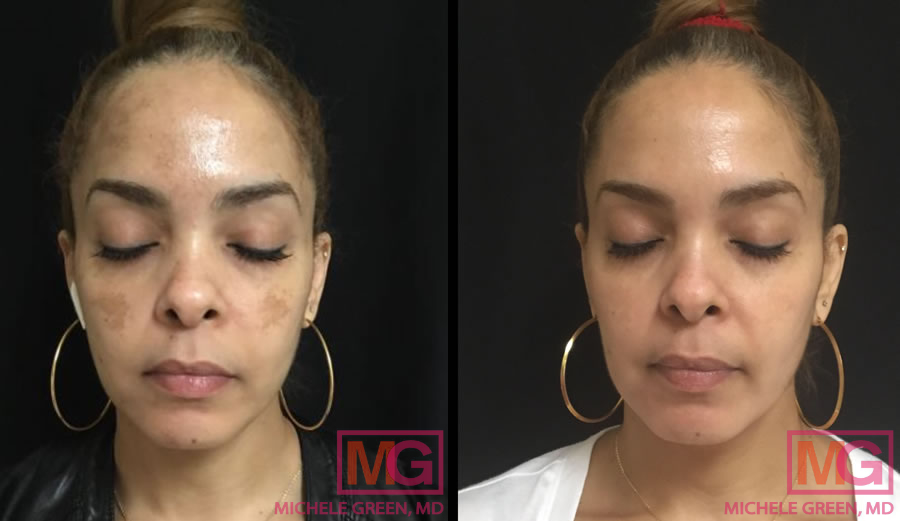
Cosmelan – 10 weeks before and after
Frequently Asked Questions (FAQs) about the Cosmelan Peel
Who is the Mesoestetic company?
The Mesoestetic company is a leading global provider of depigmentation treatments. Mesoestetic has transformed the way melasma and other skin discolorations are treated by offering several innovative methods for pigment control, including the Cosmelan peel, which is suitable for patients of all skin tones, especially those with darker complexions, such as individuals of Asian, Hispanic, Mediterranean, and African American backgrounds.
Mesoestetic also offers Mesopeel and Dermamelan Intimate, two non-invasive cosmetic treatments designed to reduce hyperpigmentation. Mesopeel is a gentle, specially formulated chemical peel designed to treat hyperpigmentation on the face, neck, chest, back, around the eyes, underarms, inner thighs, and groin. Dermamelan Intimate is a cosmetic treatment that lessens hyperpigmentation in sensitive areas, including the buttocks, groin, and vaginal and anal regions. These depigmentation options are safe and effective for patients of all skin tones and types. If you notice hyperpigmentation elsewhere on your body, Dr. Green can evaluate if Mesopeel or Dermamelan Intimate is suitable for you.
What is Cosmelan treatment?
The Cosmelan Peel is a powerful depigmentation treatment that delivers quick, lasting skin-lightening results. Its active ingredients work to reduce excess melanin and block the enzyme tyrosinase, which is essential in melanin production. The procedure starts with the application of the Cosmelan 1 mask, followed by a detailed skincare routine that includes the Cosmelan 2 depigmentation cream and other home care products. The Cosmelan treatment is highly effective for all skin types and tones because of its proven active ingredients. It is important to understand that the Cosmelan treatment is meant to correct hyperpigmentation and promote an even skin tone; it does not lighten your natural skin color.
Does Cosmelan lighten skin?
Cosmelan is a depigmenting cosmetic treatment used to target unwanted hyperpigmentation. It contains active skin-lightening agents like salicylic acid, retinol, ascorbic acid, kojic acid, arbutin, and phytic acid to boost cell turnover, reduce melanin production, and regulate melanogenesis. It is not designed or used to lighten your natural skin tone.
Which is better, Dermamelan or Cosmelan?
Both Dermamelan and Cosmelan are chemical peels created by Mesoestetic to address hyperpigmentation. However, these peels are designed for different areas of the body. Dermamelan is specifically formulated to treat discoloration and hyperpigmentation in sensitive areas, including the groin, buttocks, genital-perineal area, perianal region, mons pubis, and inner thighs. Cosmelan is formulated to treat hyperpigmentation and melasma on the face and other body parts.
Which is better, Microneedling or Cosmelan?
Microneedling is a minimally invasive cosmetic treatment that helps create a more youthful, clearer, and radiant appearance. During the procedure, tiny surgical-grade needles puncture the skin, causing small injuries that activate the body’s natural healing process to produce new collagen and smooth the skin. The main benefit of microneedling is its ability to stimulate new collagen production, reduce fine lines and wrinkles, and refresh the skin. When combined with a targeted depigmentation serum containing active skin-lightening ingredients, microneedling can also help diminish hyperpigmentation, melasma, and dark spots.
While microneedling can help create a more even-toned complexion, it is typically best for treating superficial and mild hyperpigmentation. For moderate to severe hyperpigmentation, stubborn melasma, or post-inflammatory hyperpigmentation from improper laser treatment, Dr. Green often recommends the Cosmelan peel over microneedling. Cosmelan is highly effective in treating hyperpigmentation across all skin types and tones, and has been clinically proven to reduce unwanted hyperpigmentation by up to 95% with just one application of the mask. When you consult with Dr. Green at her private Upper East Side dermatology office, she will evaluate your skin type, tone, and the severity of your hyperpigmentation to develop a personalized treatment plan that effectively targets your unwanted pigmentation.
When to start Cosmelan 1 & 2
Cosmelan is an excellent chemical peel for anyone with hyperpigmentation, dark spots, melasma, or post-inflammatory hyperpigmentation. Typically, it is best to start Cosmelan in the fall or winter when there is no sun, as the ingredients in Cosmelan 1 and 2 can make the skin photosensitive. Additionally, it is crucial to avoid the sun during the Cosmelan process, as UV exposure can worsen existing hyperpigmentation or cause the recurrence of previously treated dark spots. After consulting with Dr. Green, she will create a timeline for your treatment plan and help you determine when to start the process and when to have the Cosmelan 1 mask applied. The Cosmelan 2 cream should be started 7 days after the Cosmelan 1 mask application.
When to use Cosmelan 1 & 2
The main difference between Cosmelan 1 and Cosmelan 2 is their function as skincare treatments. Cosmelan 1 is a medical-grade mask that must be applied by a healthcare professional in a clinical setting, such as a board-certified dermatologist’s office, like Dr. Michele Green’s in New York City. The Cosmelan 1 mask should be worn for a specific duration, which Dr. Green will determine based on your skin tone, the severity of your hyperpigmentation or melasma, and your skin type. After this time, you should remove the Cosmelan 1 mask with a gentle facial cleanser. On the other hand, Cosmelan 2 is a depigmenting skincare cream for patients to use at home, designed to boost the effects of the Cosmelan 1 mask. Unlike the Cosmelan 1 mask, the Cosmelan 2 cream does not need to be rinsed off after applying. Instead, a small amount should be applied to the hyperpigmented areas and allowed to absorb into the skin. Cosmelan 2 can be used once or twice daily, depending on how well you tolerate the cream.
What is Cosmelan 2 cream?
Cosmelan cream usually refers to Cosmelan 2, a depigmentation product. This cream contains active skin-lightening ingredients such as retinol, salicylic acid, kojic acid, ascorbic acid, arbutin, phytic acid, and two patented depigmenting compounds (melaphenone and cosmesome) to improve the results of the Cosmelan 1 treatment and further reduce unwanted hyperpigmentation.
How to use Cosmelan 2 cream
The Cosmelan cream, or Cosmelan 2, should be used 7 days after the initial application of the Cosmelan 1 mask. Patients should begin by applying the Cosmelan cream once at night. After cleansing, they should apply a small, pea-sized amount of the cream only to the dark spots on their skin. The cream should sit for 15 minutes to ensure full absorption. Then, patients should apply the Melan Recovery moisturizer to their entire face. If they tolerate the Cosmelan cream well, they may increase use to twice daily.
Some patients may experience irritation with Cosmelan cream, including redness, dryness, flakiness, or stinging in the treated areas. If irritation happens, stop using the cream and inform Dr. Green, as it could cause further darkening of the area. Dr. Green will then provide you with instructions on how to use the Cosmelan at home. Dr. Green might suggest reducing the use of Cosmelan cream or switching to a different one if it’s not tolerated.
Can you use Cosmelan 2 without Cosmelan 1?
It is recommended to use the Cosmelan 1 treatment first before applying Cosmelan 2 cream. Some patients use Cosmelan 2, a depigmentation cream with multiple active ingredients, to reduce melanin production and lighten the skin. However, using Cosmelan 2 alone may be less effective because it is meant to support and enhance the results of the Cosmelan 1 treatment. If you’re interested in using Cosmelan 2 without the Cosmelan 1 mask, it’s best to consult an experienced, board-certified dermatologist like Dr. Green for advice.
Can I use Cosmelan 2 forever on my face?
No, the Cosmelan peel is not intended for permanent use. It is formulated to correct and regulate melanin production in the skin. After applying the Cosmelan 1 mask, Cosmelan 2 can be used at home for several months to improve treatment results. Once you complete the Cosmelan treatment, Dr. Green will provide a personalized skincare plan to protect your skin from harmful UV rays, prevent hyperpigmentation from returning, and help you achieve a bright, healthy complexion that lasts.
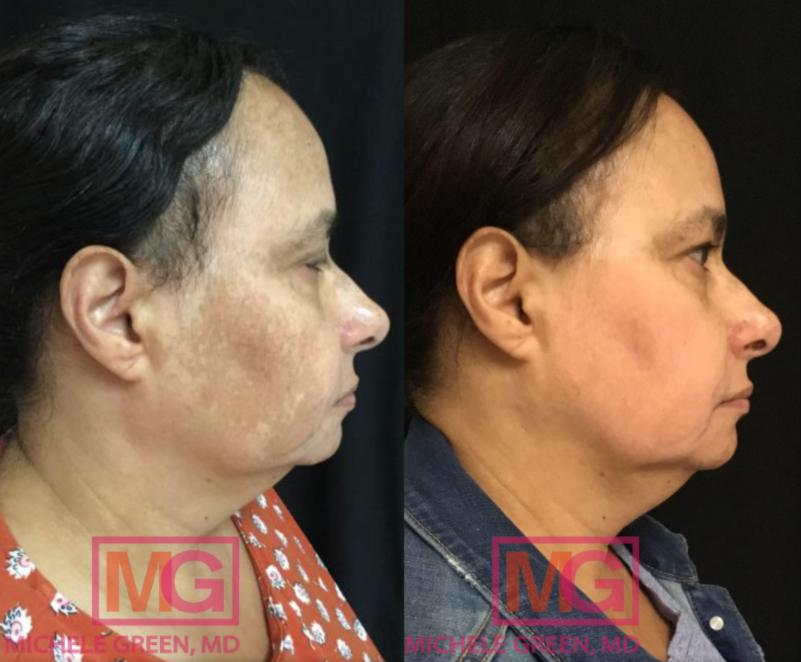
How long does Cosmelan last?
Cosmelan treatment can deliver very long-lasting rejuvenation results, often requiring only one application of the Cosmelan 1 Mask for many patients. By strictly following the aftercare instructions provided by Dr. Green, the results of your Cosmelan depigmentation procedure could be permanent. Limiting sun exposure to the treated area and carefully adhering to the at-home maintenance plan will help you maintain a clear, healthy, radiant, and evenly toned complexion. If hyperpigmentation returns after treatment, patients can undergo another Cosmelan session or opt for other depigmenting cosmetic procedures with Dr. Green.
Do I wash off Cosmelan?
The initial Cosmelan 1 application should be rinsed off after the time specified by Dr. Green. How long the mask stays on the skin will differ among patients, depending on their skin type and tone, as well as the severity of hyperpigmentation. However, the Cosmelan 2 depigmentation cream should not be rinsed off. Once applied, it must remain on the skin for 15 minutes to penetrate. Patients can then apply the Melan Recovery moisturizer over the entire face.
Does Cosmelan have hydroquinone in it?
No, the current formulation of Cosmelan does not contain hydroquinone. The Cosmelan peel includes active ingredients, such as various tyrosinase inhibitors that decrease melanin production in the skin. The main tyrosinase inhibitors and lightening agents are kojic acid, phytic acid, ascorbic acid (vitamin C), retinol, salicylic acid, niacinamide, and melaphenone (a proprietary tyrosinase inhibitor molecule).
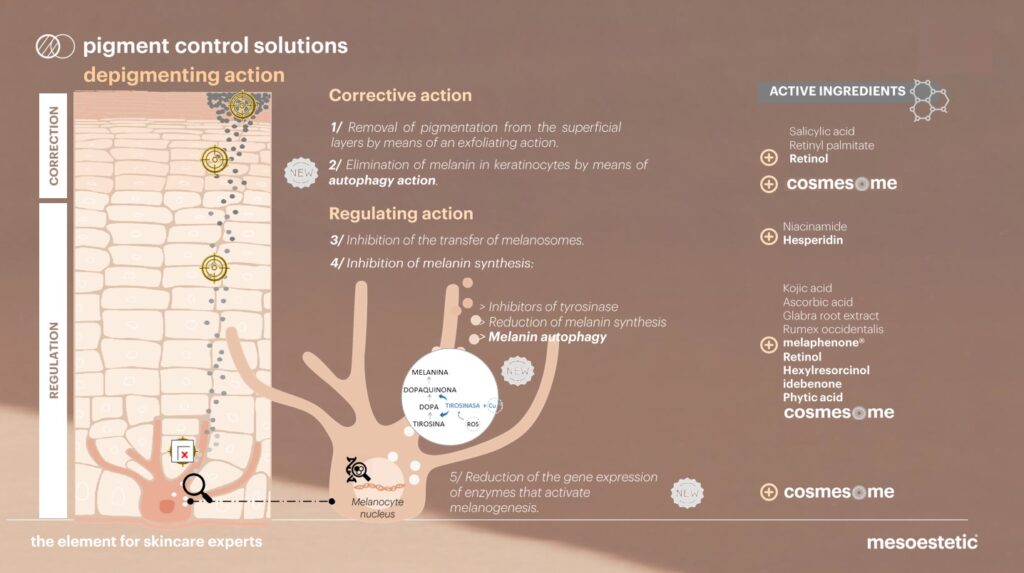
Can Cosmelan be used during pregnancy?
No, it is not advisable to use Cosmelan during pregnancy or while breastfeeding due to the retinol and salicylic acid in the Cosmelan 1 and 2 formulations.
Has Cosmelan been discontinued?
The Cosmelan peel has not been discontinued and is still available at Dr. Michele Green’s private dermatology office in New York City.
Where to buy Cosmelan peel
Cosmelan is the world’s leading depigmentation treatment and is popular worldwide among patients seeking to address unwanted hyperpigmentation. Many patients are eager to start their treatment and often ask, “Can I do the Cosmelan peel at home?” The Cosmelan peel is a professional, medical-grade chemical peel that must only be performed by an experienced healthcare professional, such as board-certified dermatologist Dr. Michele Green in NYC. During the Cosmelan procedure with Dr. Green, she will apply the Cosmelan 1 mask in her office and provide you with the Cosmelan 2 cream, a Cosmelan at-home kit, and other essential skincare products to help you treat and manage your hyperpigmentation.
Is the Cosmelan peel worth it?
Yes! The Cosmelan peel is one of the most effective treatments for hyperpigmentation and melasma. It successfully treats various types of hyperpigmentation, including melasma, sun spots, dark spots from previous acne, and post-inflammatory hyperpigmentation from improper laser treatments. Unlike other treatments, the Cosmelan peel is safe and effective for patients of all skin types and tones. With few side effects, minimal downtime, and consistently impressive results that last, most patients agree that the Cosmelan depigmentation procedure is well worth it. When you receive the Cosmelan depigmentation treatment with Dr. Green at her private dermatology office in Manhattan’s Upper East Side, you can trust that you will attain a healthy, radiant, and more even skin tone.
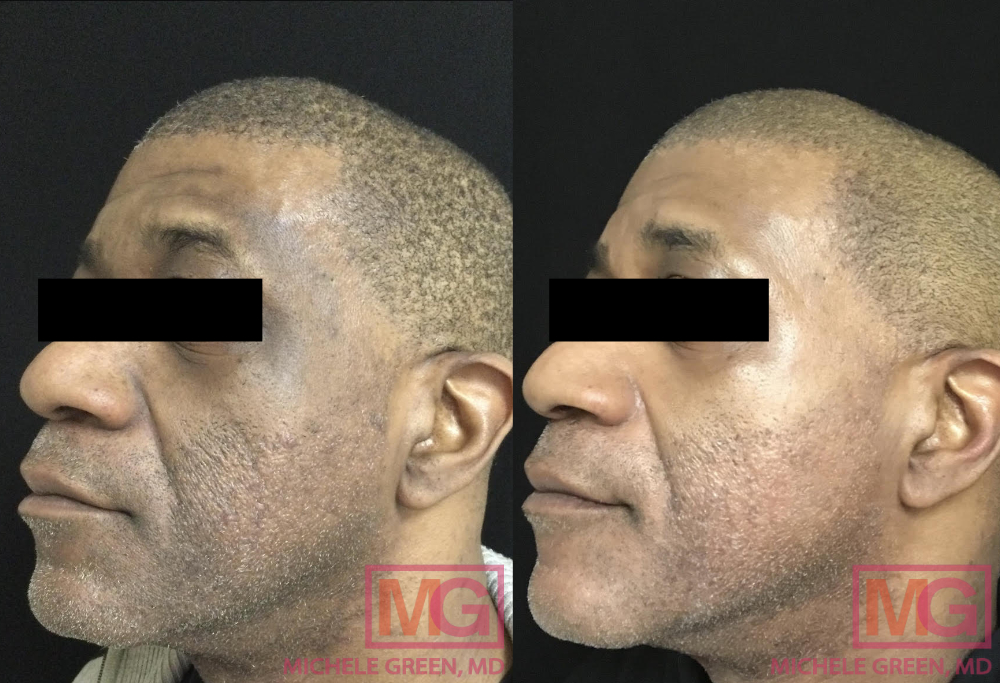
45-54 year old male, Cosmelan – 2 months before and after
How to get started with the Cosmelan peel today?
The Cosmelan Peel is the leading depigmentation treatment worldwide, effectively reducing hyperpigmentation and regulating melanin production for long-term skin rejuvenation. Whether Cosmelan is used to treat melasma, post-inflammatory hyperpigmentation, sun damage, or other types of hyperpigmentation, this medical-grade, multi-phase treatment encourages a healthy, radiant, and even skin tone in patients of all skin types and tones. With minimal potential side effects and downtime, along with consistently impressive cosmetic results, the Cosmelan treatment is among the most popular procedures at Dr. Green’s private dermatology office in Manhattan’s Upper East Side. If you’re ready to improve the appearance of your facial hyperpigmentation or melasma, Dr. Green is here to help.
Dr. Michele Green is an internationally recognized, board-certified dermatologist with over 25 years of experience providing non-invasive cosmetic treatments to some of the world’s most selective clients, including the Cosmelan peel, microneedling, Botox, and dermal fillers. She is often recognized by Castle Connolly, Super Doctors, The New York Times, and New York Magazine as one of the top dermatologists in New York City for her dedication to her patients and expertise. Dr. Green uses a holistic, less-is-more approach to facial rejuvenation, tailoring each treatment plan to address individual concerns and aesthetic goals. During your consultation with Dr. Green, she will work closely with you to create a personalized rejuvenation plan to help you achieve and maintain a healthy, glowing complexion and an even skin tone. If you’re ready to start your custom treatment plan today, schedule a consultation with Dr. Green by contacting us online or calling the NYC office at 212-535-3088.
 212-535-3088
212-535-3088